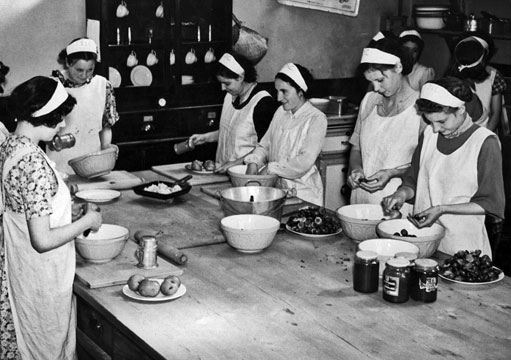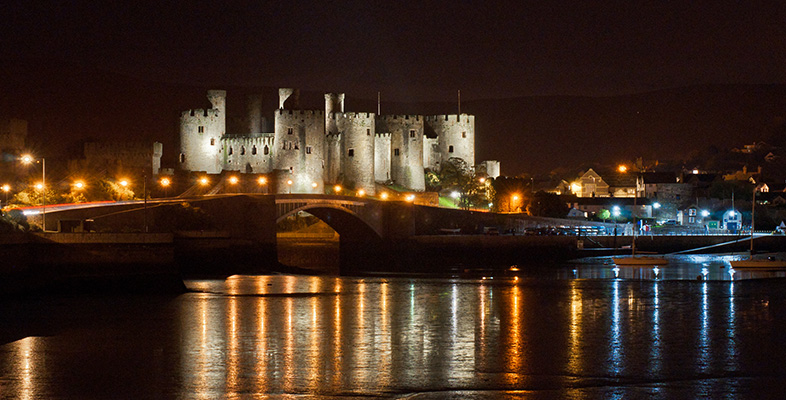4.2 Thinking about gender and Wales
If thinking about ‘race’ in Wales has been characterised by notions of ‘no problem here’, then thinking about gender has been influenced and characterised by women’s gradual emergence ‘out of the shadows’ and by perceived shifts in gender roles.
Thinking about gender, and particularly about women, has changed since the start of the twentieth century. For much of that century, thinking was dominated by the doctrine and practice of ‘separate spheres’:
Separate spheres meant separate worlds for men and women. Man’s sphere was the public domain of work and politics; woman’s sphere was the private world of home and family. Man’s duty was to provide financially for his wife and family through money earned in the outside world. Woman’s duty was to be a wife and mother and to create a home which was a refuge from the forces of darkness outside its walls: under her care home would be a centre of Christian virtue, moral purity and sobriety.
This doctrine dominated the early years of the century, an era in which ‘women wore long skirts and large hats, travelled in horse drawn vehicles, worked as live-in domestic servants (or employed them) and were denied the basic rights of citizenship’ (Beddoe, 2000, p. 13), and it retained much of its power and significance through the course of two world wars. The period 1914–39 saw little fundamental change to gender roles. The First World War did see gender barriers in employment break down a little, but the role of women was still fundamentally in the home. Cardiff-born Ivor Novello’s wartime song urged women to ‘Keep the Home Fires Burning’ and after the war women were expected to resume their roles as wives, mothers and dutiful daughters.
The period of the Second World War again saw women come out of the home and into work – both ‘war work’ and civilian jobs vacated by men – but this war too ‘did little more than superficially dent the notion of separate spheres’ (Beddoe, 2000, p. 133). In post-war Wales, women remained custodians of the home and family, and men remained the breadwinners.
This picture of gender roles in the early years of the 20th century is arguably one that could apply to many western societies, and certainly to other parts of Britain. But is there a Welsh dimension to the account?

Activity 9
Can you think of anything about Wales and Welsh culture that might explain why separate spheres, ideas and practices were so well entrenched in Welsh society for much of the twentieth century? Make a note of your ideas.
Then read Extract 2 by Deirdre Beddoe below, and compare your ideas with what she writes.
Extract 2
Clearly the lives of women in Wales have been shaped by a distinctive Welsh culture, which has largely been defined by Nonconformity ... ministers of religion, politicians and other male public figures zealously promoted the domestic ideology and the role of women as a civilizing force within the home. This, in turn, imposed on women in Wales a whole set of prescriptive rules: they were to be ‘respectable’, with all that word entails. The chapel policed their behaviour: women were cast out of chapels as late as ... the 1960’s for becoming pregnant while unmarried or on reports of adulterous behaviour. ... In terms of women’s paid employment there has also been a distinctive Welsh dimension ... the nature of industrialisation in Wales meant that there was very little paid work for women in the mining valleys before 1939 ... the war identified factory work as women’s work and post-war opportunities meant that women began to enter the workforce in increasing numbers, despite a great deal of male hostility. ... It can be argued too that Welsh women were subjected to a particularly ‘virulent strain’ of patriarchy. The nature of men’s work in Wales, in heavy, dirty and dangerous jobs ... meant not only that women’s unpaid work was essential in the home, but that in Wales, work itself was defined in exclusively macho terms: only men’s work was real work. ... In Wales there was a particular male pride in being able to support a ‘nonworking’ wife. The legacy of the nineteenth-century notion of separate spheres lingered longer in Wales, keeping women, with few exceptions, out of the public sphere.
Discussion
In this passage, Beddoe identifies four factors in Welsh culture and society that shaped the lives and experiences of women:
- a strong Nonconformist culture
- the role of the chapel
- the nature of industrialisation
- a virulent strain of patriarchy.
Such factors lie behind the ‘Welsh Mam’ representation of Welsh women as hardworking, pious and clean: responsible for the home and the well-being of her family, she was immortalised in Richard Llewellyn’s novel How Green Was My Valley (1939).
But women’s wartime experiences had enhanced their confidence and raised their expectations, and the period from 1945 onwards was to witness much tension and unease as women sought to reconcile notions of supposed freedom and equality with experiences of oppression, unease and frustration. Yet it was not until the 1970s that these ‘feelings’ found expression and new ways of ‘thinking’ about gender emerged. As Beddoe puts it: ‘a growing feminist consciousness and influences from the USA, together with a rising tide of anger about equal pay, would turn vague stirrings of discontent into a new mass feminist movement in the 1970’s’ (2000, p. 158).
The last decades of the twentieth century saw many changes in the lives of women in Wales. Women became more visible, in work, in education, in organised religion, in social movements and eventually in politics. The new Welsh post-industrial economy with its expanding service sector provided the conditions for women’s increased participation in the labour market. The Women’s Liberation Movement (WLM) brought attention to the oppressed position of women and campaigned tirelessly for change on a wide range of issues. Strongest in the urbanised southeast, there were WLM groups throughout Wales, particularly in university towns. Thinking about women and the particularities of women’s experiences came to assume an academic profile. Courses in women’s studies developed in all of the higher education institutions in Wales in the 1980s and 1990s. Research was undertaken and new publications appeared with the aim of filling the huge gaps in knowledge and playing a part in the ongoing struggle to change attitudes and improve opportunities for women in Wales.
One such text was Our Sister’s Land (Aaron et al., 1994), which highlighted the tension between the old images and stereotypes of gender roles and the transformations that were currently occurring. The editors suggest the book shows that:
Welsh women are ... to a greater or lesser extent, in the process of change ... in both the private and public sphere, a growing diversity of patterns of women’s lives and identities challenges popular images of women in Wales; at the same time, structures which perpetuate gender divisions at home and work remain stable.
This recognition of both change and continuity at the end of the twentieth century is endorsed by Beddoe, who writes: ‘there can be no doubt that the last thirty years have seen substantial gains for women, but on the other hand, in the year 2000 it is certainly premature to talk of equality between the sexes in Wales. The old gender hierarchy remains – with men on top’ (2000, p. 178).
So what of the 21st century? What progress has been made; what remains to be done? Has our thinking about gender and gender divisions changed?
